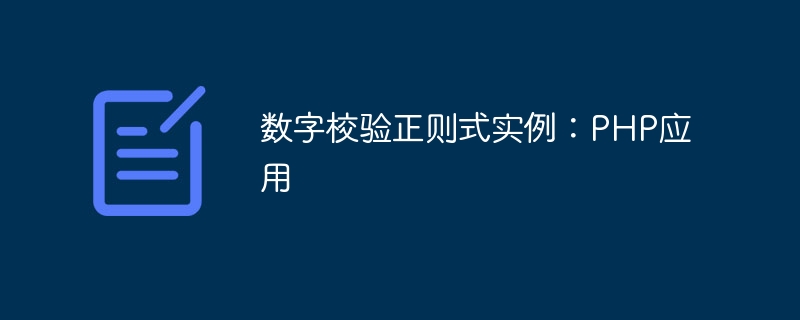Home >Backend Development >PHP Tutorial >Example of digital verification regular expression: PHP application
Example of digital verification regular expression: PHP application
- 王林Original
- 2024-03-20 17:42:04703browse

Numbers are a vital element in the information world. Whether in data storage, computing or communication transmission, numbers occupy an important position. However, when processing digital data, problems such as incorrect format and incomplete data are often encountered. In order to ensure the accuracy of the data, digital verification is an indispensable part. In programming, regular expressions are a powerful tool that can be used to verify and match data. This article will use PHP language as an example to introduce how to use regular expressions for digital verification, and also give specific code examples.
First of all, we need to clarify the number type that needs to be verified. In practical applications, common number types include integers, floating point numbers, positive integers, negative integers, etc. To simplify the example, we take positive integers as an example. A positive integer is an integer greater than or equal to 0, excluding the decimal point and negative sign.
In PHP, regular expression matching can be easily performed using the preg_match function. Here is a simple example code that checks if the input string is a positive integer:
<?php
function checkPositiveInteger($input) {
$pattern = '/^d $/'; // Match regular expressions that start and end with one or more digits
if(preg_match($pattern, $input)) {
echo "The input string is a positive integer";
} else {
echo "The input string is not a positive integer";
}
}
$input1 = "12345";
$input2 = "abc123";
$input3 = "-123";
checkPositiveInteger($input1); // Output: The input string is a positive integer
checkPositiveInteger($input2); // Output: The input string is not a positive integer
checkPositiveInteger($input3); // Output: The input string is not a positive integer
?>In the above example, we defined a function called checkPositiveInteger to check whether the input string is a positive integer. By defining the regular expression pattern '/^d $/', we can ensure that the input string contains only numeric characters and does not contain any extra characters. If the input string conforms to the format of a positive integer, the preg_match function will return true, otherwise it will return false.
It should be noted that the '^' in the regular expression represents the beginning of the string, '$' represents the end of the string, 'd' represents any numeric character, and ' ' represents matching one or more the previous expression. By flexibly using these metacharacters, we can easily write various complex regular expressions to meet different verification needs.
In practical applications, digital verification is a very common function. Whether it is user input verification, data transmission verification or data storage pre-processing, digital data needs to be effectively verified. Through the flexible use of regular expressions, we can quickly and accurately implement digital verification functions to ensure the integrity and accuracy of data.
In short, regular expressions are a powerful and flexible tool that can play an important role in various programming languages. In PHP applications, by rationally using regular expressions, we can easily implement various digital verification functions and improve the stability and security of the program. I hope the sample code in this article can help readers better understand and apply digital verification regular expressions.
The above is the detailed content of Example of digital verification regular expression: PHP application. For more information, please follow other related articles on the PHP Chinese website!

